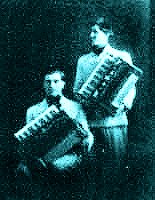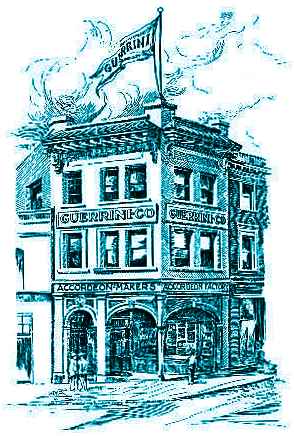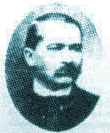 The Milano Duo (1909)
The Milano Duo (1909) Guido and Pietro |
by Guido Deiro
In the fall of 1908, I arrived in the City of Seattle, and State of Washington, my brother at this time was playing at the Idaho Saloon where he had been for about two months. He was playing the three row, sixty bass semi-tone accordion that I had traded with my brother in Germany. He was playing by ear, accompanied by a pianist. His salary was $18.00 per week. The owner of the saloon was Frank Butti. Mr. Butti gave me a position in his other saloon, called the "Jackson Saloon." He also paid me $18.00 per week. I played alone. My repertoire consisted of a very large collection of grand opera pieces, including fifteen waltzes by the Greatest Composer in Europe, Waldteufel and Strauss. I played the famous Tesoro Mio Waltz, and the Sharpshooters' March, the first time it had ever been played in this country.
At this time my brother and I were living at the Idaho Hotel. My brother at that time did not know anything about the piano accordion. He had a piano accordion but he could not play it because the instrument was then unknown, and no teacher could be had to teach him on it. Naturally, I had to teach my brother how to play the piano accordion. A few months later I ordered a new piano accordion from Italy, manufactured by Ranco Vercelli; this accordion had eight rows of basses, they were divided into 96 basses, 6 rows and two rows of chromatic; 41 keys on treble, with the octave shift in treble and a shift for tremolo. When I received this instrument I was playing at the "India Bar" my salary then was $25.00 per week. When I received my new instrument it was badly damaged on the trip from Italy. I met a man by the name of Perrone, an accordion player. He had just arrived from San Francisco; he was in possession of an accordion made by Galeassi. It had 24 basses and 39 keys chromatic. He advised me to take my damaged instrument to Guerrini Accordion Manufacturing Company in San Francisco. At that time my brother was still playing at the Idaho Saloon with Peter Morello, piano player.
 Guerrini Accordion Company
Guerrini Accordion Company279 Columbus Avenue San Francisco, California |
 Pasquale Petromilli
Pasquale Petromilli
|
The day before returning to Seattle, I gave an open-air concert, standing on a stool in front of the Guerrini Manufacturing Company, before a crowd of hundreds of people. The police had to be called to maintain order. This concert was very highly complimented by such enthusiastic accordion players as Dave Rossi, Adolfo Mosconi, Genio Gannarini and Joe Valle. These men were then the greatest chromatic accordion players on the Pacific Coast. After this concert I returned immediately to Seattle. This was in February, 1909.
I got a better job from Mr. Tates, playing at his "Oriental Poolroom" with a piano player, Peter Morello. My salary at this time was $40.00 per week. After a few months, in order to give my brother the opportunity to become a great player, I arranged with my boss to have him play with me. Owing to the fact that he was not a finished player, I taught him to play second parts with me. We played together for nine months, my brother in the meantime wanted to have a new accordion made, so we got together, and I ordered the instrument for him from Guerrini. This was in the fall of 1909.
We received the accordion, but it was not up to our expectations. The keyboard was placed in the middle of the case instead of on the side, and owing to the fact that my brother had long and large fingers, he could not play it. He was broken hearted over it, so I persuaded him to go to San Francisco and have Guerrini rebuild his keyboard. He did this, leaving immediately for San Francisco, when his instrument was satisfactorily rebuilt.
While he was in San Francisco he met a man by the name of Porcini (a guitarist and singer). They got together and organized a duo called "The Milano Duo." Mr. Porcini secured an engagement for one week at a small theatre in the Italian district called the "Washington Square Theatre." The theatre was owned by Mr. Johnson and it was booked by Tony Lubesky and Ella Weston. While my brother played in that engagement, I arrived in San Francisco. Mr. Johnson one evening presented me to the audience, asking me to play a couple of tunes with my brother. My brother and I were then engaged by him for the next week, without Mr. Porcini the singer.
After that week with the Washington Square Theatre, we were booked by Tony Lubesky at the Portola Louvre, on the same bill with us was the famous Spanish Dancer "Estrollita." Owing to the audience making so much noise with glasses and while they were under the influence of liquor, we quit after the first day.
That was the end of my brother and I as an accordion duet. Mr. Porcini the singer, who was first with my brother, took me for his partner, and my brother left for Seattle. I played with Mr. Porcini under the name of "The Milano Duo." We played all over California in the major theatres outside of the Orpheum Circuit. That was in the early part of the year 1910. In the month of May 1910, we were booked to play the Orpheum Circuit for three weeks, at Salt Lake City, Spokane and Seattle. We were dressed in white flannels and wore straw hats. While playing in Spokane, I met a very good accordionist by the name of Santo Santucci. He was playing a semi-tone accordion in an act called "The Bella Napoli Troupe." While playing in Seattle, Mr. Santucci and I went to see my brother, who was then not working but studying music.
From Seattle we went to San Francisco again. The manager of the American Theatre at that time in San Francisco was Sid Grauman, his son at present is manager of the Chinese Theatre in Hollywood. Mr. Grauman suggested that I let the singer go and that I do an act alone, so I opened at the American Theatre, June 15th, 1910, billed Deiro, American Premier Piano Accordionist. I was dressed in a white flannel suit, black bow tie, using a chair for the first two numbers. My program was:
1st, Poet and Peasant Overture
2nd, Dill Pickles Rag
3rd, My Treasure Waltz
4th, I Got a Ring on My Finger
That was the first time that the piano accordion was called that name, and the first time that it appeared on the vaudeville stage.
The photograph of the Milano Duo at the top of this page is an enlargement of a detail from an 8x10-inch glass negative of the Guerrini Accordion Company (1903-1968) display booth at the 1915 World's Fair (San Francisco, California) courtesy of Hal Layer. To see the original photograph, go to http://online.sfsu.edu/~hl/a.html.
Back
Next